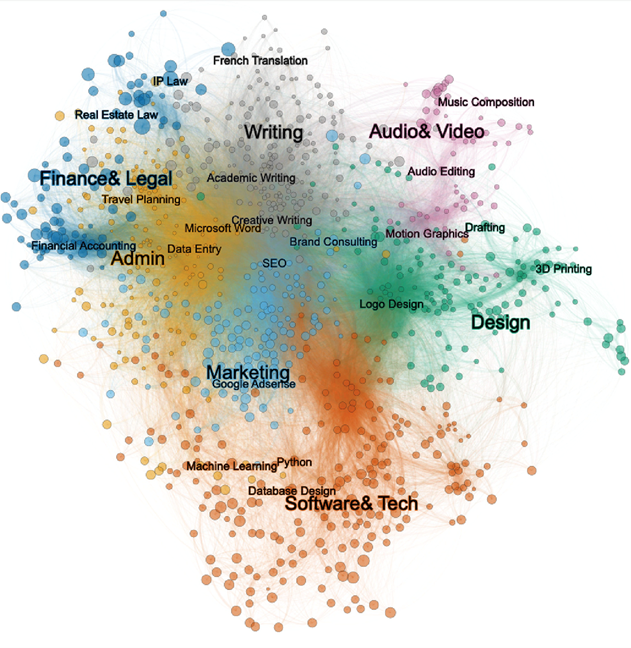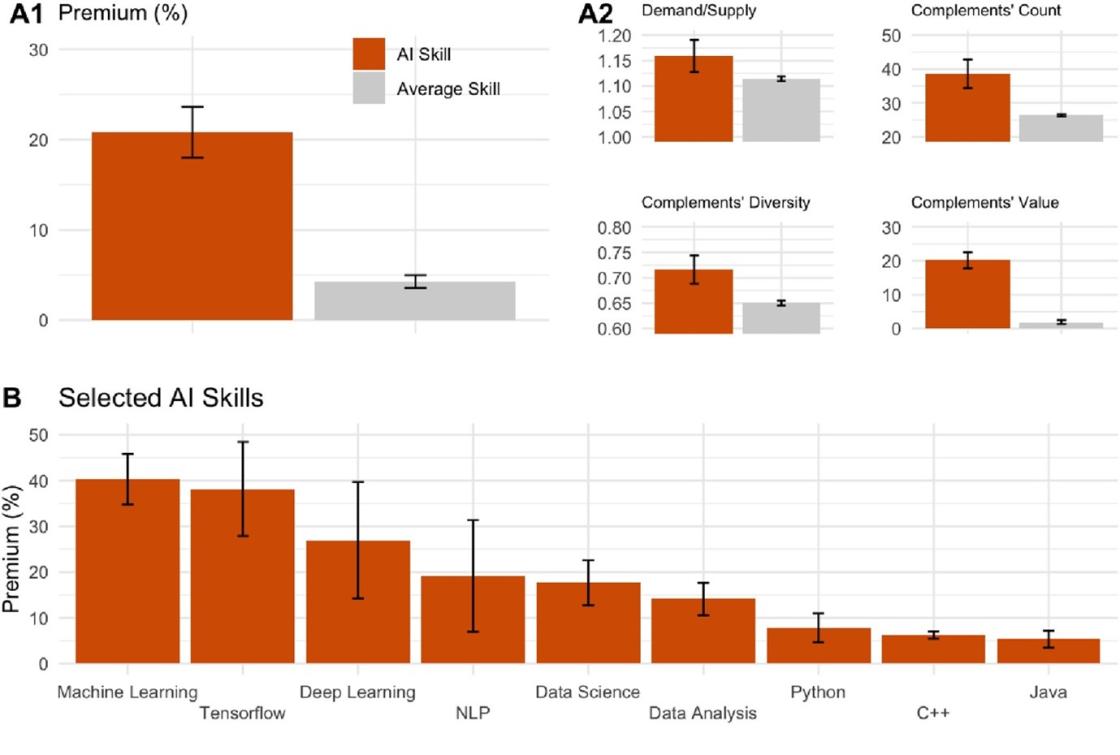The value of skill complementarity, especially in artificial intelligence
Understanding skill complementarity can help workers and employers keep up in the increasingly high-tech world of work

The pace of technological and social change has quickly outstripped the ability of national training systems and employers to keep up. This is a fear particularly in relation to artificial intelligence – think, for example, of ChatGPT for summarising information, or Dall-E for image generation, and their potential impacts on creative industries. Workers face uncertainty about which skills will secure their futures. The dilemma is further complicated for those who have already invested in their current skill sets and who have limited resources to embark on entirely new career paths. In this context, how can workers and firms identify the skills they should invest in?
Complementarity: the key to a skill’s value
To address this question, we analysed a decade’s worth of project history of about 25,000 knowledge workers, including graphic designers, software developers and business accountants (Stephany and Teutloff, 2024). This data contains information on completed projects, including the time, location, duration, wage and skills applied to complete a certain set of tasks. We found that complementarity is the key to determining the value of a skill. Complementarity refers to how well a skill complements and enhances other skills. It matters for three reasons:
- Skill sets: skills are rarely applied in isolation. Most jobs require a combination of skills. Therefore, the value of a skill can be assessed only in the context of the skills that complement it.
- Reskilling efficiency: as workers adapt to new technologies, they add new skills incrementally to their existing skill sets. Maximising complementarity between old and new skills is crucial for economic efficiency in this process.
- Strategic value: as a particular skill’s set of complementary skills becomes more diverse, a worker has more strategic options for reskilling. This increases their resilience against unforeseen labour market shocks.
Figure 1 illustrates how the skills in our dataset are related. In the upper panel of Figure 1 each dot represents a skill. Two skills are connected if a worker has applied them together. The more closely two skills are related in this network, the more frequently they have been applied together.
Based on this logic, we have identified seven groups of skills, which relate to different areas of knowledge work: finance and legal; marketing; software and tech; design; admin and management; writing; and audio and video. This first preliminary analysis shows that skills of similar type (same colour in Figure 1) and wage premium (dot size) cluster together. We further applied econometric modelling in our paper to investigate how the ‘neighbourhood’ of adjacent competencies determines a skill’s wage premium 1 We explain the variance in skill premia using a regression model that incorporates factors including supply, demand and complementarity, which covers the number, diversity and value of adjacent skills. .
Figure 1: Relationships between skills

Source: Stephany and Teutloff (2024).
The value of a skill is influenced by complementarity in three ways. First, options matter. A skill is more valuable if it can be combined with numerous other skills. Second, the value of a skill depends on the variety of other skills it can be combined with. The more diverse the ‘neighbourhood’ of complementary skills is, the more valuable a skill. Third, both the number and value of complementary skills affect a skill's worth. A skill is more valuable if its complements are also high value. In addition to complementarity, skills become more valuable if they are in high demand relative to the available workforce.
AI skills: a valuable resource
To put our concept of complementarity into practice, we went on to focus on skills related to artificial intelligence. AI is at the forefront of technological innovation, creating new opportunities and demands for specific skills (Maslej et al, 2023). In our model, AI skills, such as programming languages and data analytics, have proven to be particularly valuable – increasing worker wages by 21 percent on average, compared to workers who do not have these skills (Figure 2).
Figure 2: AI skills pay off

Source: Stephany and Teutloff (2024). Note: The error bars refer to 95 percent confidence intervals.
Figure 2 shows that AI skills are special. With a premium of 21 percent, AI skills are far more valuable than the average skill (4 percent wage premium). It is likely that some of the AI premium can be explained by complementarities. Workers can combine AI skills with a larger set of other skills. Also, these adjacent skills stem from all domains of knowledge work. This makes them highly adaptable and valuable in a variety of contexts. They have entered various fields of knowledge work, from graphic design to translation work to software development. Perhaps most importantly, the skills that complement AI skills are of high economic value, too (Figure 2, panel A2). AI skills combine with the most valuable capacities across different fields.
In addition, part of the AI premium stems from sustained demand. There is a significantly higher level of demand for AI skills (projects requesting these skills) than supply (workers providing these skills), compared to the average skill in our dataset.
Though AI skills are clearly among the most valuable of skills in our dataset of 962 skills, there are sizable differences in the value of different AI skills (Figure 2, panel B).
Reskilling: empowering workers and firms
Findings on skill complementarity have implications for individuals, businesses and policymakers. Skill recommendations can be tailored to each individual's existing skills, ensuring they are well-equipped for the future. Learning how to code, most likely, would benefit everybody. But the rewards from learning a specific programming language depend crucially on the skills a worker can combine the newly learned capacity with. For organisations, investing in the development of AI skills among their workforce is an investment in the future (Acemoglu and Restrepo, 2018). This is a strategic move that will boost productivity and help companies protect themselves against technological disruption (Bessen, 2019).
The world of work is evolving, and adaptability is the key to success. Understanding the complementarity of skills is essential to make informed decisions about where to invest in skill development. The choice of which new skill to learn might pay differently, depending on the starting set of skills.
Our research supports policy approaches that advocate personalised learning strategies and more flexible certification options for skills acquired through vocational training, short courses or training programmes. These flexible certifications, often referred to as ‘micro-credentials’, are in high demand (Orr et al, 2020) to ensure that workers and employers are equally well-equipped to navigate the ever-evolving landscape of the future of work.
References
Acemoglu, D. and P. Restrepo (2018) ‘The race between man and machine: implications of technology for growth, factor shares, and employment’, American Economic Review 108: 1488-1542
Bessen, J. (2019) ‘Automation and jobs: When technology boosts employment’, VoxEU, 12 September, available at https://cepr.org/voxeu/columns/automation-and-jobs-when-technology-boosts-employment
Maslej, N. L. Fattorini, E. Brynjolfsson, J. Etchemendy, K. Ligett, T. Lyons ... R. Perrault (2023) The AI Index 2023 Annual Report, AI Index Steering Committee, Institute for Human-Centered AI, Stanford University, available at https://aiindex.stanford.edu/report/
Orr, D., M. Pupinis and G. Kirdulytė (2020) Towards a European approach to micro-credentials: A study of practices and commonalities in offering micro-credentials in European higher education, Publications Office of the European Union
Stephany, F. and O. Teutloff (2024) ‘What is the price of a skill? The value of complementarity’, Research Policy, 53(1), available at https://doi.org/10.1016/j.respol.2023.104898
This was produced within the project "Future of Work and Inclusive Growth in Europe" with the financial support of the Mastercard Center for Inclusive Growth.



